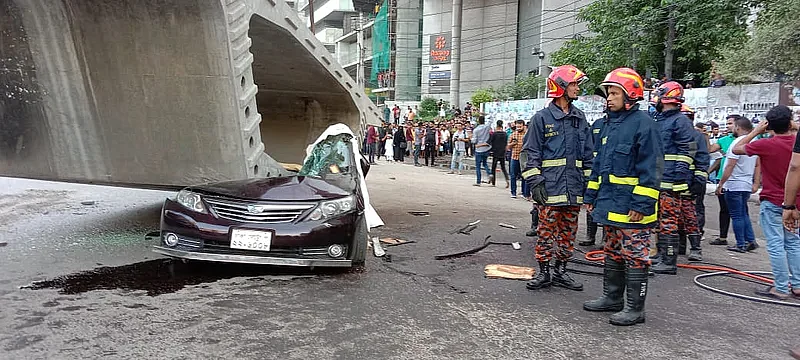
BRT project
Project plagued with negligence, cost overrun and accidents
It is the responsibility of the project authorities to keep traffic movement normal during construction above an street. Potholes and ruts in the road have to be fixed regularly.
Ensuring safety of the vehicles and people on the road is also a part of the project. The rule is to encircle the construction site.
However, none of these rules were followed in the Bus Rapid Transit (BRT) project running for about a decade on the capital’s busy Airport Road.
The BRT project aims facilitate bus movement on a 20 km route stretching from Hazrat Shahjalal International Airport to Gazipur’s Joydebpur through a special lane.
Since the beginning of the construction, four severe accidents have been caused by the collapse of the BRT flyover girders. Most recently, a girder dropped on a car at Jasimuddin Road area in Uttara of the capital on Monday. Five, including children, died in the incident.
Earlier on 15 July, a security guard died, crushed under a girder in Gazipur. On 14 March last year, two incidents of girders collapsing occurred in a single day at the Airport and Abdullahpur areas. This injured six people including three Chinese citizens, involved in the construction.
Sources engaged with the construction said, the girders are shaped like the English letter ‘I’, weighing about 40-45 tonnes each. Slabs are to be placed on the girders and road will be constructed for bus movement. These heavy girders were being set up without any type of safety barrier. Plus, questions can also be raised on the capacity of the cranes that were being used.
According to the project-related documents, construction of the BRT project taken up in 2012 has been divided in four parts. Among them, construction of the flyover and road is being handled by three Chinese companies, China Gezhouba Group, Jiangsu Provincial Transportation Engineering Group and Weihai International Economic and Technical Cooperative.
The responsibility of building the depot in Gazipur had been entrusted to local company SEL-UDC, who has completed the work already. But, the Chinese companies are still working though the project was scheduled to finish within 2016.
Concerned sources say, the contractors are in a financial crisis. There are questions about their competence too. That’s why the progress rate is slow while there is dissatisfaction over the quality of work.
Deep potholes were created on the road’s Airport to Joydebpur stretch since the beginning of the construction towards 2017. There were waterlogging problems between Abdullahpur and Joydebpur for three long years. Sometimes crossing that 20 km stretch takes four to five hours, due to different obstacles including cracks, potholes and waterlogging.
Four agencies are employed in the implementation of the BRT project. Three of are under the jurisdiction of the road transport and bridges ministry while road transport and highways division is the coordinator.
ABM Amin Ullah Nuri, secretary of road transport and highways division, told Prothom Alo on Monday night, people being crushed to death by a girder is deplorable. He had asked for a report within the night. Concerned people will surely be held accountable for the negligence of duty and mismanagement, he had added.
Slow progress and cost overrun
Dhaka BRT project, taken up for rapid bus movement in between capital’s Hazrat Shahjalal International Airport and Gazipur, has created an example of slow project progress too. The five-year project is running for about ten years now. The progress in the project was 81 per cent till last July. In the meantime, the cost has increased by 109 per cent which stands at Tk 22.25 billion in monetary value. The Roads and Highways Department is the main agency involved in the construction. The department has switched six project directors till now.
The BRT project was approved by the Executive Committee of the National Economic Council (ECNEC) for a cost of 20.40 billion on 1 December 2012. Asian Development Bank (ADB), French Development Agency AFD, the Global Environment Facility and Bangladesh government are financing the project.
Negligence right at the beginning
Experts say, a preliminary study is required at the very beginning of a large-scale project. The project then starts after the final survey. Sources of the road transport ministry said, ADB in 2011 did the first feasibility study in constructing BRT. However, the project was taken up before the study and design were completed. This created various problems in implementation.
For instance, during construction it was found that there was no proper drainage system at the project site. Water started accumulating. Nor was there were any alternative idea about how to keep up regular vehicular movement during construction on the busy road.
Project sources said, the flyover in the BRT project was first designed with box girders. But, it was switched to ‘i’ girders as insisted by the contractor, two years after starting the construction. It was said that there won’t be enough space if box girders were used.
In 2019, an underpass was included in the BRT project to help people cross the road in the airport area. Tk 4.2 billion was added to the total cost because of this.
Transport expert and professor at the civil engineering department of Bangladesh University of Engineering and Technology (BUET), Shamsul Hoque, told Prothom Alo, measures are taken lessen risks and avoid accidents in construction work. If any accident occurs even after that, preparations must be there to manage the situation. None of these were there in the BRT project.
First of all, the girders are being lifted on a busy street without setting any sort of obstruction. Cranes for rescue or ambulances to transport injured to the hospital after an accident, were supposed to be on spot, but were not there. This is an example of extreme negligence of duty.